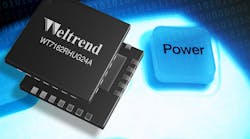Check out more of our APEC 2023 coverage. This article also is part of the TechXchange: Power Supply Design.
Gallium nitride (GaN) is storming into the world of power electronics. Its fast switching speeds and other unique physical properties continue to pay dividends at a system level, including higher levels of power efficiency and smaller form factors, while reducing costs.
Despite pushing the limits of power density and switching frequency, GaN FETs aren’t drop-in replacements for MOSFETs, and they pose challenges when it comes to system design.
To ease these challenges, Transphorm released its first SuperGaN FET in a system-in-package (SiP). With the ability to pump out 45 to 100 W, the power IC is specifically designed for USB Type-C PD power adapters for everything from mobile phones, tablets, and laptops to a wide range of other battery-powered consumer devices. Developed with Weltrend Semiconductor, the WT7162RHUG24A will be on display at APEC 2023 this month.
Integrating a multi-mode flyback PWM controller from Weltrend and Transphorm’s 240-mΩ, 650-V SuperGaN FET, the SiP device delivers peak power efficiency of more than 93% and high-frequency switching of up to 180 kHz.
“It enables manufacturers to develop a less expensive system solution given fewer components are required and a smaller PCB can be used among other advantages,” said Weltrend President Tony Lin. “It also reduces system development time. Effectively, we’re removing design barriers.”
GaN belongs to a class of wide-bandgap semiconductors that’s shaking up the world of power electronics, as chips based on the material can facilitate higher power densities at a given voltage and current level than today’s silicon MOSFETs.
Superior Features of GaN
The electrical characteristics of GaN, which is generally used at voltage ratings of up to 650 V, enable it to handle 10X stronger electric fields and deliver higher power in a smaller form factor than silicon MOSFETs.
What stands out about GaN is that it reduces parasitic capacitances for a given on-resistance (RDS(on)), giving it inherently fast switching transients relative to silicon MOSFETs. These qualities help keep power losses to a minimum and limit heat that can sap the system’s performance.
High-frequency switching also allows for the use of smaller passive components. Heat dissipation is enhanced due to the higher thermal conductivity of GaN, which pulls heat out of the power devices more efficiently.
With its high switching speeds and smaller device capacitances, GaN is opening the door to more compact chargers and power adapters that can supply hundreds of watts of power at a time—sufficient to speed up charging or even charge laptops, smartphones, and tablets at once from a single power supply. Housed in 24-pin, 8-× 8-mm QFN package, the new GaN-based SiP delivers high power density of 26 W per cubic inch.
To boost overall efficiency, the ac-dc controller inside the GaN SiP runs in quasi-resonant (QR) mode when under heavy loads and discontinuous conduction mode with valley switching during light load.
The USB PD 3.0 device is optimized for wide output-voltage operation. It includes a programmable power supply (PPS) feature that makes it possible to adjust the output voltage in increments as small as 20 mV ranging from 3.3 to 21 V. Protections against brownout, overvoltage, open loop, and output short-circuits are built-in. The GaN-in-SiP prevents overcurrent and overtemperature situations as well.
Integrating the ac-dc controller in the same package as the GaN FET keeps costs in check by limiting the number of necessary components in the system. It also reduces parasitics (inductance, resistance, capacitance), helping to limit electromagnetic interference (EMI).
The companies said the GaN power IC, which still needs to be paired with a USB PD 3.0 controller and EMI filter in the final system design, will start sampling by the second quarter of 2023.
Check out more of our APEC 2023 coverage. Also, read more articles in the TechXchange: Power Supply Design.

